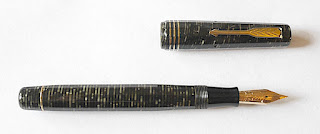Our second day in DC took us to capitol hill for our tour of
Congress. This is the most basic tour and when we arrived at 9:00 the place was
jam packed with tour groups of all ages, plus folks like us.
 |
| You line up with dozens of school groups, some well mannered, some not, for security screening. |
Sharon was offended by the orientation film that presented
Congress as a functional body.
The tour consisted mostly of the old House chamber and then
the vaults. Our guide, Carrie from Massachusetts, delivered the tour well and,
more importantly, maneuvered us among about a dozen other tour groups. It was a
cluster, to be sure, but worth doing.
 |
| The old house chambers swarm with groups and tour guides maneuvering, for the most part successfully, around one another. The guides are as much as anything, traffic managers. Today this is a hall of statues, two from each state. |
From there we went to the Library of Congress or as they
call themselves LOC. Much less crowded and with more exhibits this was more
interesting to us both. Over the years as a Stanford librarian, Sharon has
worked with colleagues from LOC and looks to the Library as does everyone in
her world. And I recall researching there briefly back in the late 1970s when I
was working on my dissertation. We were a bit late for the tour but caught them
up in the main entry and I was relieved to learn that the building had been
restored in the late 1980s and that before that it was drab, with the ceilings
concealed above and the remarkable polychrome covered by decades of grime,
which was how I remembered it, and not in this glory.
The display on the 1964 Civil Rights Act and its history was
moving as was the replication of Mr. Jefferson’s library, which formed the core
of the LOC.
 |
| This modest entry opens into a spectacular chamber |
 |
| Obligatory Gutenberg bible |
 |
| Ceiling vault |
 |
| Minerva |
 |
| From the mezzanine you get a much better sense of the grandeur of this building |

 |
| The Supreme Court |
We decided not to walk the 1.6 miles from Congress to the
White House, the stairs up and down in Congress and the Library had left us
both sore.
The White House is the White House, both glorious in its
republican simplicity and a symbol of the might of the government of the United
States. For the most part, ordinary citizens like us no longer get to see the building that Andrew Jackson first threw open to the people. What more to say?
 |
| Lafayette Park opposite the White House. |
 |
| The White House. It does say something positive about us that this protest, however peaceful and harmless, has been allowed to remain for more than thirty years |
 |
| Across the street, the old State Department building, now the Executive Office Building. The earliest policies toward the Soviet Union, which formed the core of my dissertation, were formed here. Cordell Hull later railed about "That man across the street [Franklin D. Roosevelt] who never tells me anything." |
 |
| I could not walk past this solitary, quiet symbol of the security state sitting here. I don't know what DC was like in wartime (WWI and II, but it probably was less intense than the security here and at the hill. And I don't know how I feel about the need for it all. |


























Comments